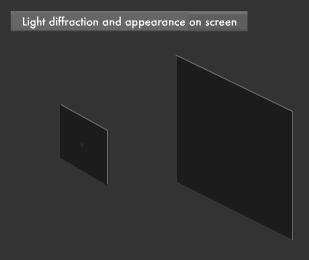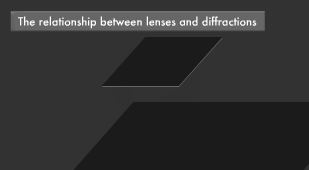Canon Science Lab
Why Light Fades in the Bathroom?
The intensity of an electrical light seems to fade in the bathroom or other locations, where the humidity is high. This is also why the intensity of streetlights seems to fade on foggy days. What phenomena are working here?
Light has two kinds of properties of electromagnetic waves and particles. The phenomena we have just mentioned result from diffraction, which is one of light's characteristics as a wave. Diffraction occurs when light hits and bends around an object. In a bathroom, light hits steam particles, which cause it to bend around and fade.
There Are Two Types of Wave Diffraction
Diffraction occurs when light hits an obstacle, and then bends around the edge of the object. The light bends as shown in Figure 1. Figure 2 shows another light diffraction example through a slit in the board. Light is also a wave, so if it goes through a narrow slit or small hole, it changes from a plane wave to a spherical one. This transformation is the same as with waves of water. Diffraction describes that change in light's direction. As the light wave becomes spherical, it spreads, and weakens after surrounding a small object or passing through a slit, making it seem to fade.


Light Passing through a Hole Forms Ripples
One interesting diffraction phenomenon occurs when light passes through a pinhole in a board. Light passing directly through the pinhole would seem to create a spotlight. But this is just an illusion. You actually get a circle pattern with ripples of brightness and darkness. The sharpest bright spot is at the center, and ripples expand further out around the center. We call this the diffraction image. This rippling is quantified in what we call a two-dimensional Fourier transformation. Some scientists have proposed the concept of an "optical computer," which would use the diffraction of light to make calculations with greater speed.

Light Passing through a Lens Becomes Fuzzy
A lens is a kind of hole (opening) that concentrates light to create an image. Light is also diffracted when it passes through a lens. The diameter of the diffraction spot increases with longer wavelengths light and holes with smaller diameters. With a microscope or telescope, diffraction greatly influences resolution because the object lens diameter is essentially a hole. Diffraction has a major impact on resolution because a smaller opening causes an image to fade.

In other words, even with an ideally designed lens, light will become fuzzy even when in focus, since the light is not focused on a single point. This is called the "diffraction limit of the lens. " To magnify something like a molecule using a lens, you need an object lens with a very large diameter. It is almost impossible to create such a lens, which is why scientists use electron microscopes incorporating electron beams whose wavelengths are smaller than those of light. These devices, using shorter wavelength beams, reduce the size of the diffraction image and provide high resolution.
